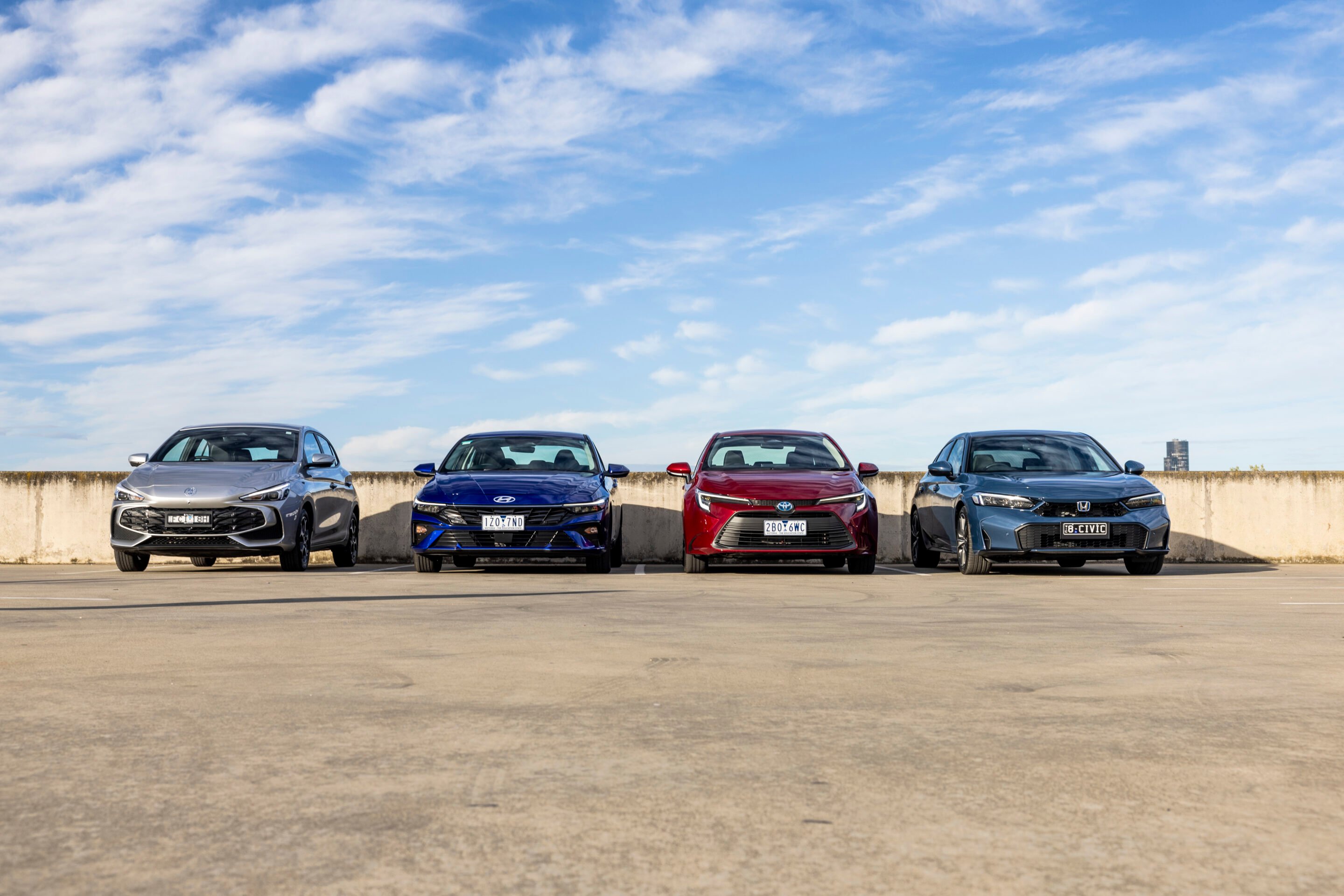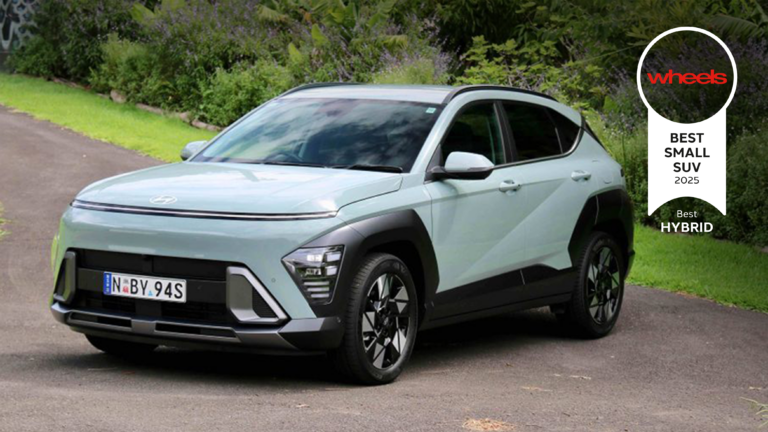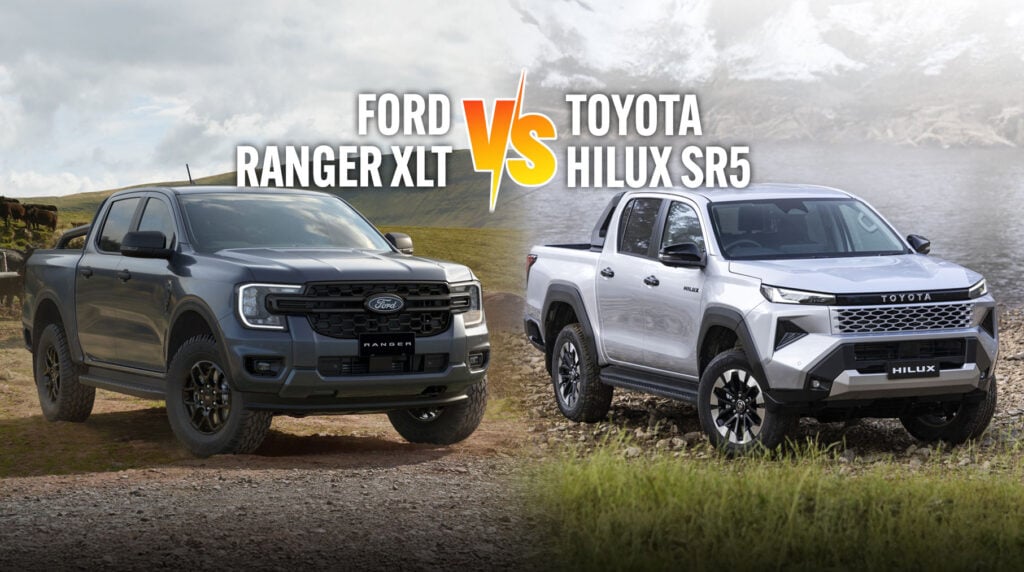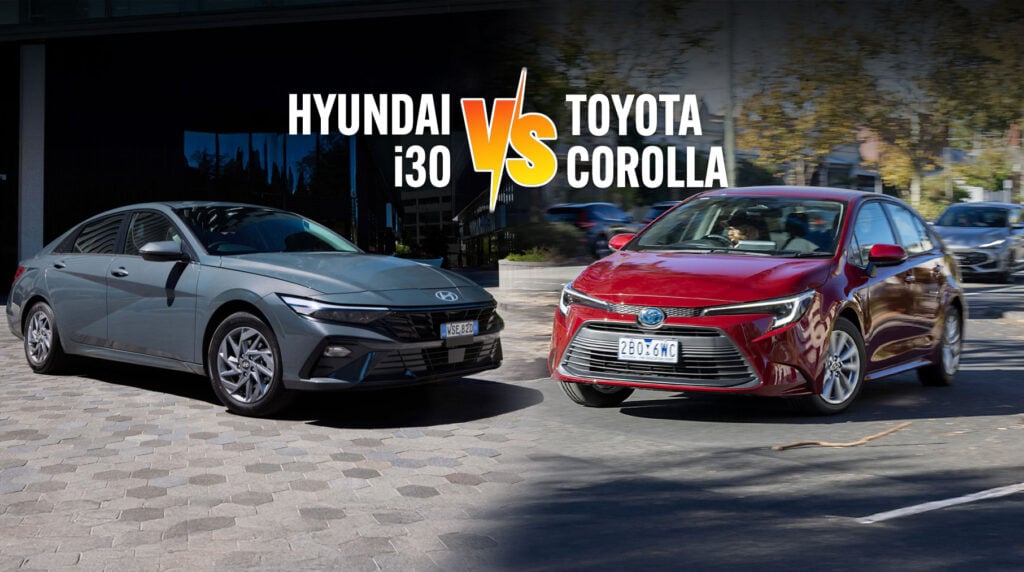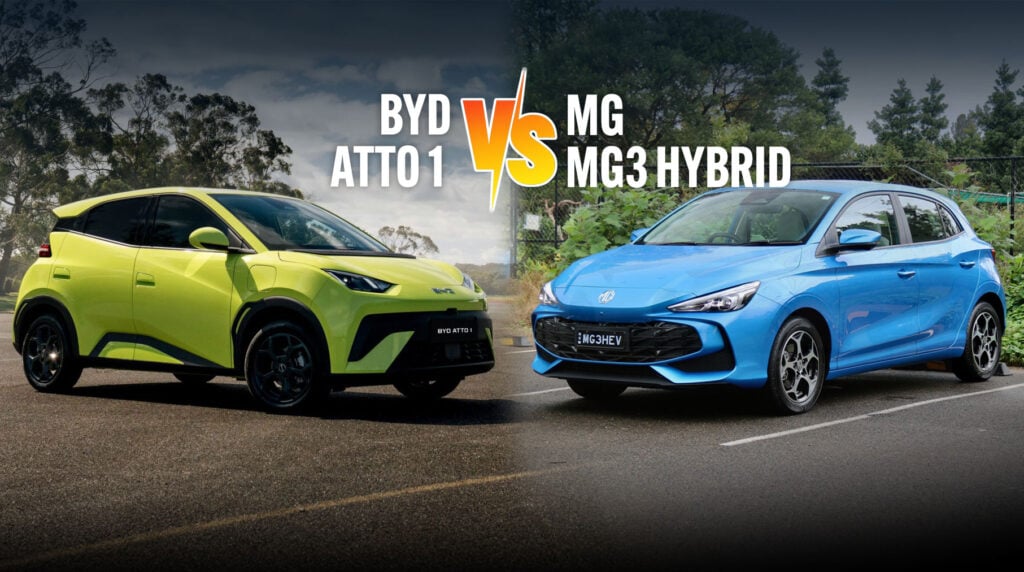Say we blindfolded you. Could you guess a Wheels comparison test based on the sounds of the cars arriving? (Ignore the zip-tied wrists and pillowcase over your head. That’s just for added effect.)
A burbling V8 might suggest a Ford Mustang – taking on something like a Toyota Supra, if you also identified a bassy straight-six. The utilitarian thrum of turbodiesels might signal a coming together of dual-cab utes. But what if you heard a sound like someone holding down half a dozen random keys on a keyboard?
Electric vehicles (EVs) would be a good guess, but today, the cars arriving are hybrids. The eerie, synthesised hum you’re hearing is an Acoustic Vehicle Alerting System (AVAS for short).
Soon, Australian city streets will hum with various digitised tones from EVs and hybrid cars. From November 2025, they all must be fitted with this system, which installs external speakers beneath the bodywork, producing artificial sound up to 20km/h to warn pedestrians who are, in theory, a bit too used to the noise of an approaching combustion engine.
The car companies can use whatever track they like and for this test, there’s the unmistakeable din of different AVAS systems in the Wheels carpark as we bring together four different hybrid systems – a top-seller, and three in close pursuit.
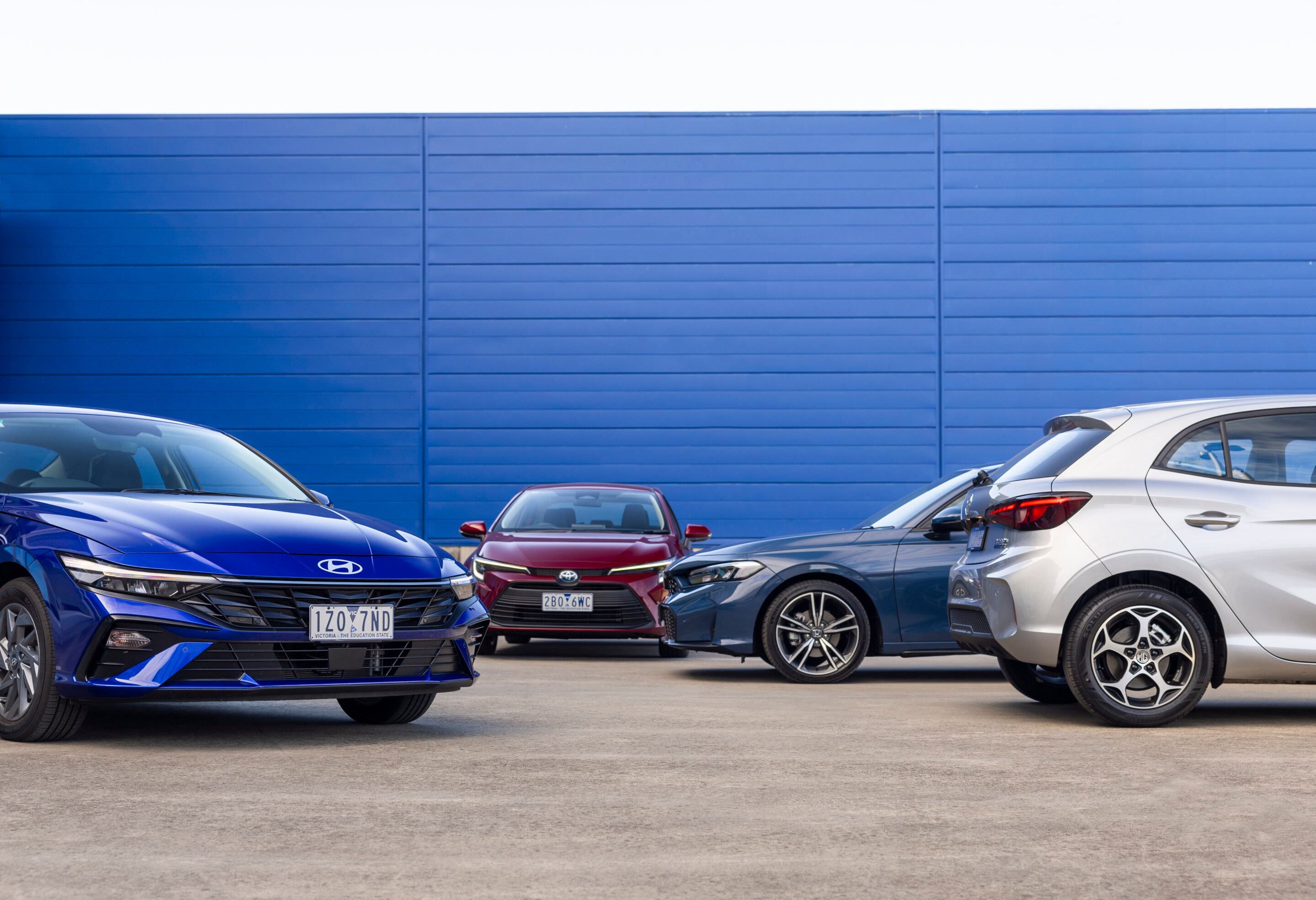
In 2025, hybrid is one of the hottest words in the Australian new car market, with sales of this type of vehicle up 80 per cent year-on-year in 2024. Australia’s top-selling non-ute was the eponymous Toyota RAV4 Hybrid. In a cost-of-living crisis, hybrids are luring Aussies with the promise of fuel bills cut almost in half, and strong resale values. That’s especially true of those still too nervous to go full EV, if not for range anxiety and having to deal with a still-fiddly public recharging network, but for residual values that haven’t quite found their footing.
The first hybrid on-test comes from the doyen of hybrids: Toyota. Between the RAV4, Corolla, Camry, Kluger and Yaris Cross hybrids, Toyota effectively owns the hybrid market in Australia.
Cars like the Toyota Corolla we have today can now only be purchased as a hybrid. Built on Toyota’s TNGA platform and having been around since 2018, the 12th-generation Corolla comes in hatch and sedan forms in Australia. We actually don’t mind the look of the sedan, especially given many hatch-based sedans of the past have resembled last-minute design studio rush-jobs.
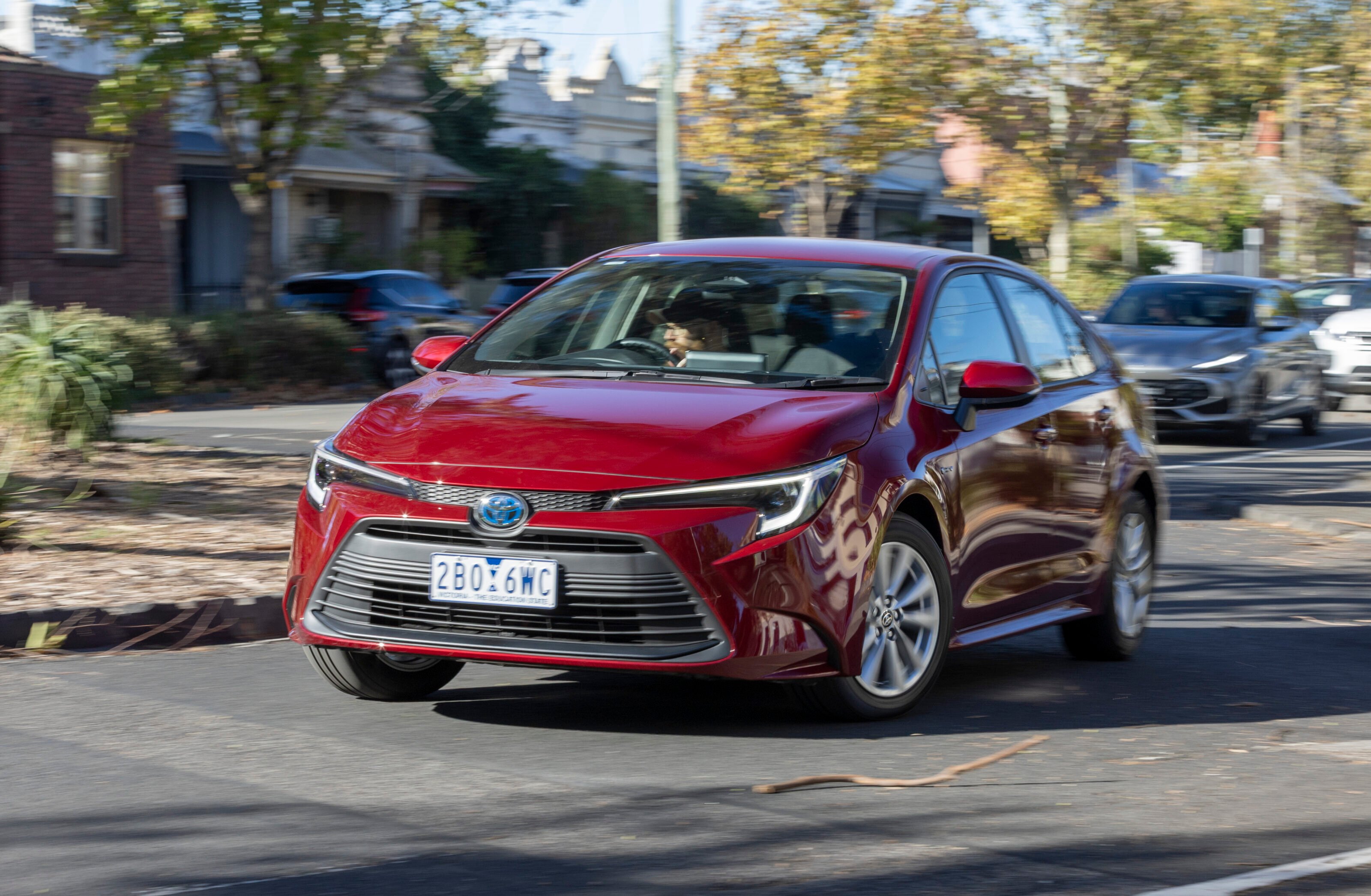
Behind its manga-inspired headlights, our Corolla Sedan Hybrid pairs a 72kW/142Nm, 1798cc Atkinson-cycle inline-four with two electric motors (with outputs of 70kW/185Nm) and an “eCVT” which uses planetary gears to achieve its infinite possible gear ratios, instead of the traditional belts. Driving the front wheels only, the Corolla Sedan Hybrid’s combined power is 103kW and claimed combined consumption is 3.9L/100km. The lithium-ion battery is 1.3kWh and the car we have is the Spartan, Uber-spec, base Ascent Sport with an MSRP of $32,320.
Just as Uber-ready, and looking like it’s narrowing its eyes and furrowing its brow like you’ve somehow offended it, is our first challenger: the Hyundai i30 Sedan Hybrid. Hyundai is leading efforts to dislodge Toyota’s hybrid hegemony, and has made amazing inroads with its own technology.
To just about everywhere outside of Australia, this car is called the Elantra, including its main market, the USA. The seventh-generation Elantra, or i30 Sedan Hybrid, does something the Toyota doesn’t – it fits a proper transmission. Its Atkinson-cycle, 1580cc inline-four produces 77kW/147Nm in isolation, but is then coupled with a single 32kW/170Nm electric motor. The system incorporates a six-speed dual-clutch transmission with a total output of 104kW, all going to the front wheels only. Storing recuperated energy otherwise lost to heat in the brakes is a 1.32kWh lithium-ion battery mounted under the rear seats.
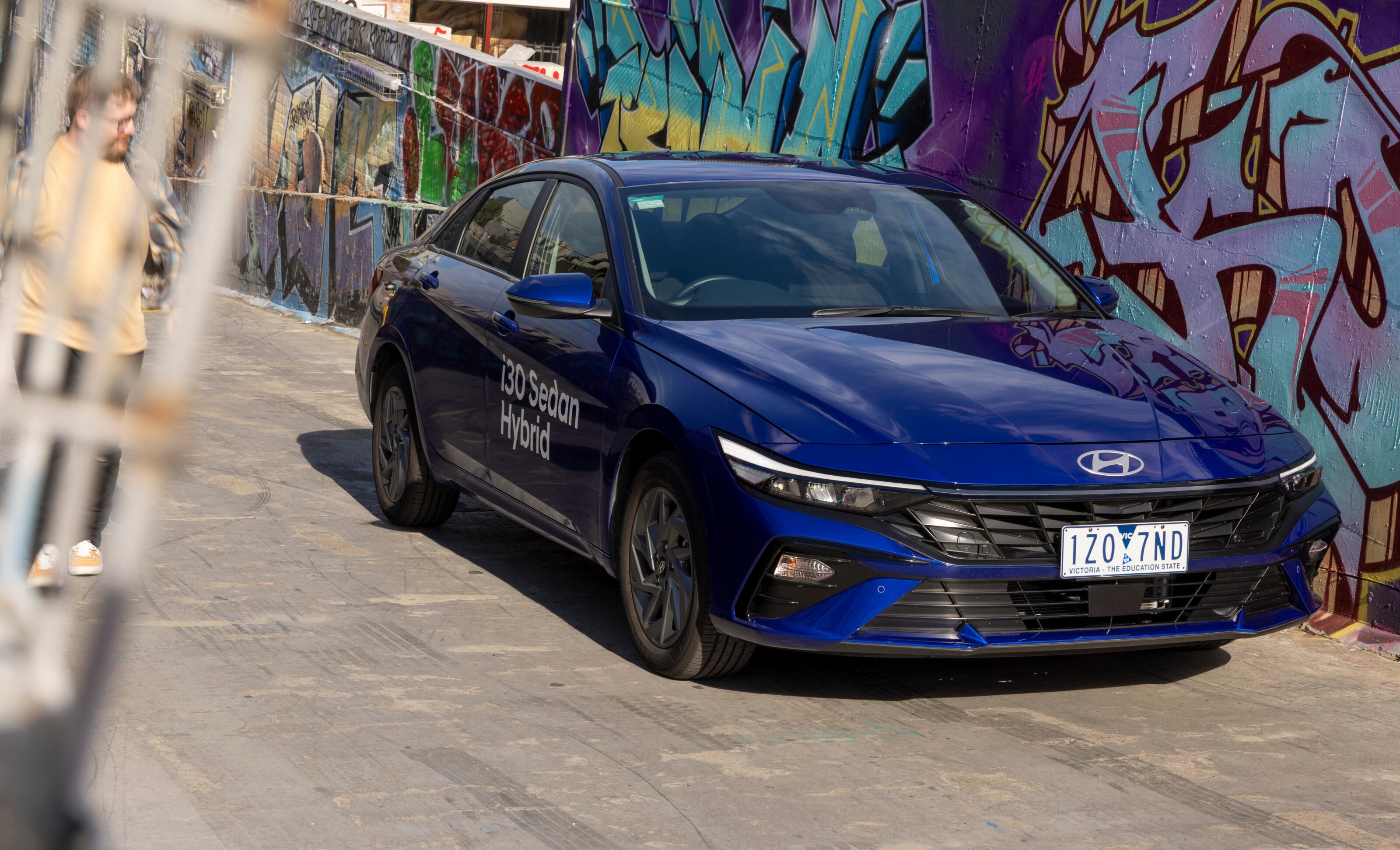
Claimed combined efficiency is 3.9L/100km while our long, swoopy test car is again cloth-upholstered inside and boggo, base-spec. It’s all yours for $33,000 MSRP.
At $29,990 MSRP, undercutting both of them on price, and besting them on standard equipment, is a car Toyota and Hyundai would probably prefer didn’t get an invite to the party: the newly hybridised,
second-generation MG3 light hatch.
As the top-selling Chinese brand in Australia in 2024, MG also ranked number seven on the overall 2024 sales charts ahead of even Nissan. Like many of its compatriot brands, MG is hungrier for Aussie customers than a panda in want of a bamboo bush. The Chinese, with their own hybrids, are now muscling in on traditionally Japanese turf.
Australian consumers are the great winners here as Chinese cars rapidly improve. Sit in a MG3, much like its fully electric MG4 hatchback brethren, and for the price it’s asking, it’s impossible not to be impressed.
As for under the bonnet, the main claim-to-fame of MG’s new hybrid system – fitted to MG3 but also the recently launched all-new ZS small SUV and soon, the HS mid-size SUV – is a larger battery and more powerful electric motor than its hybrid rivals.
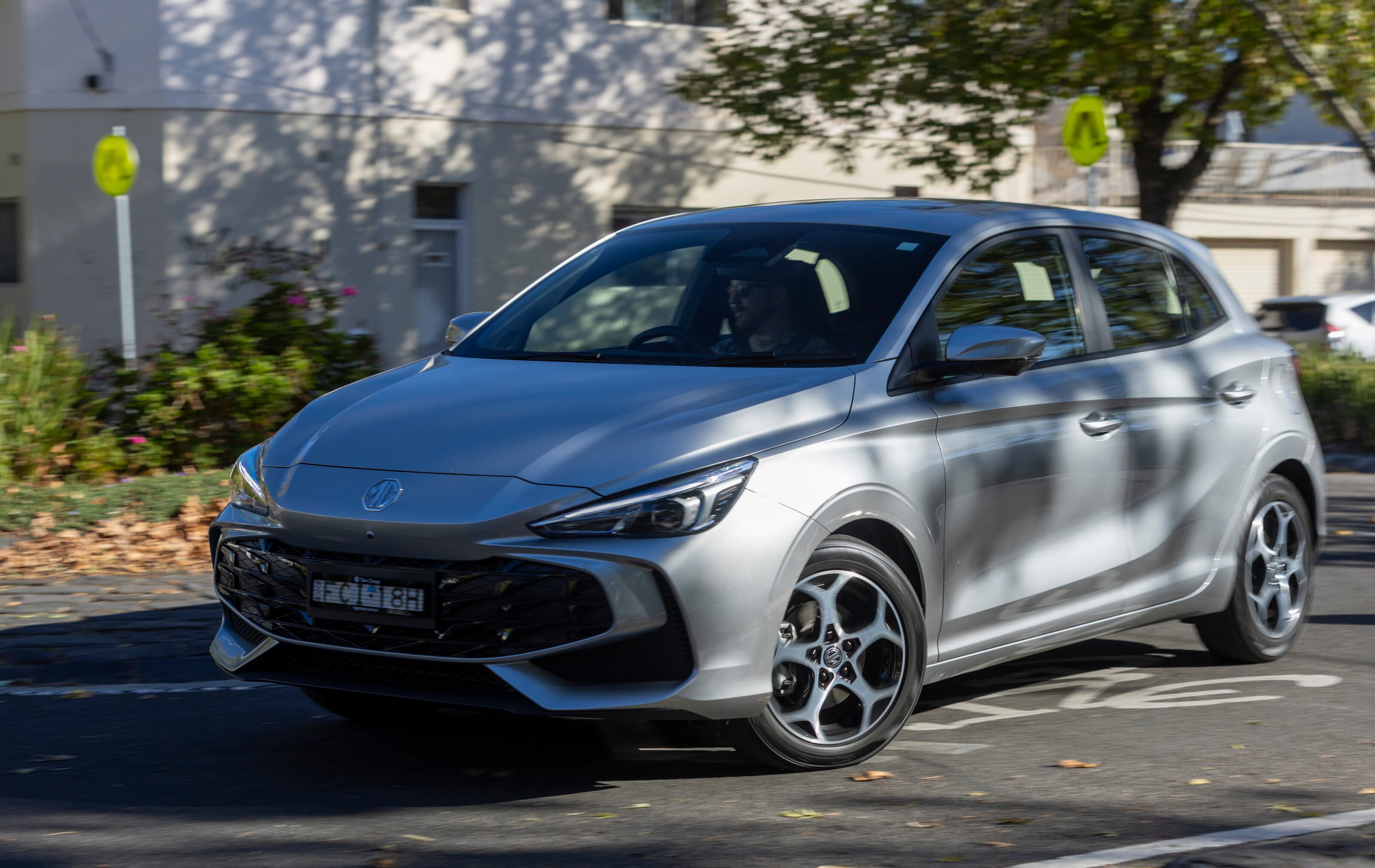
In the MG3 light hatch’s case, a 75kW/128Nm, 1498cc four-cylinder engine works with a grunty 100kW single electric motor and 1.83kWh lithium-ion battery for a combined power output of a slightly startling 155kW. That’s 50 per cent more power than the Corolla and i30, in a lighter vehicle. Interestingly, part of the MG’s front-drive, hybrid powertrain is a three-speed automatic transmission. Our MG3 HYBRID+ Essence test car claims combined consumption of 4.3L/100km.
Our last competitor could claim similar hybrid heritage as Toyota. The slippery Honda Insight took on the Prius and made its mark, and now its hybrid DNA lives on in cars like the 11th-generation Civic hatchback.
With a price tag of $55,900 drive-away (quite a lot for a Civic), today’s eHEV LX tops a two-variant range and even the ‘base’ eHEV L is just shy of $50K drive-away. Both cars come loaded with standard equipment and represent efforts by Honda, locally, to extricate itself from the piranha pool of the low-cost market now dominated by the Chinese, and position itself as something more aspirational.
These days the size of a medium sedan from yesteryear, the Civic is, to my eyes at least, the best-looking car on-test. I love the classic, five-spoke, 18-inch wheels which sit beautifully at each corner.
The Civic is also the closest car here to a pure series-hybrid (which means the car is always powered by electric motors, and the combustion engine is just a ‘generator’) – but not fully.
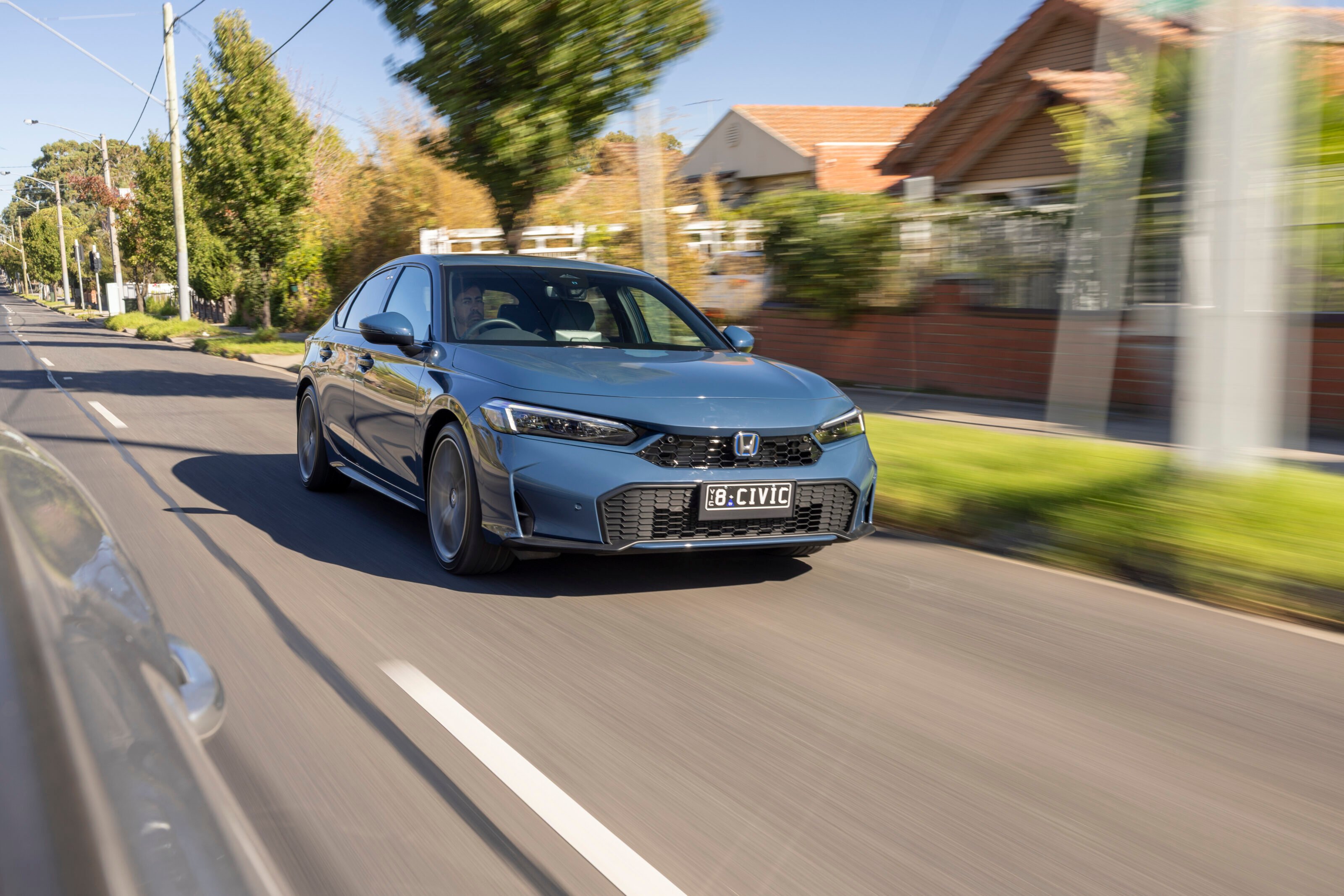
The Civic has the largest combustion engine present with a 1998cc inline-four, again running an Atkinson cycle (and a heady 13.9:1 compression ratio), producing 105kW/186Nm. Twin electric motors output 135kW/315Nm, driving the front wheels only. Honda says it has an “eCVT” but this car has no transmission at all – just a single gear with a 1:1 ratio and a lock-up clutch. At highway speeds, the clutch can connect the combustion engine directly to the wheels as needed. The battery, meanwhile, is the smallest here, a 1.05kWh unit. Honda claims combined economy of 4.2L/100km.
The brand that brought us the NSX and S2000 has very much delivered on interior quality with this Civic, as well. The first thing you notice is the seating position which is more rear-drive sports car than front-drive, five-door hatchback, mounting your hips low in figure-hugging seats. The leather steering wheel is the perfect diameter, perfect angle and is perfectly placed. And forget the Toyota and Hyundai (let alone the MG), the Honda’s cabin materials and build quality are in another league. This is a Japanese BMW.
With plenty of space and all the tech you could want, it’s the row of heating-cooling buttons and dials – which click mechanically and satisfyingly – that is novel. You’ll be tweaking the fan speed up and down just to enjoy the buttery click of the dial.
The Toyota and Hyundai continue to offer buttons for the heating and cooling, too, although they’re somewhat more functional. Still, it’s preferable to the MG which has migrated every function, including heating and cooling, regrettably into the central infotainment system.
Much like the Honda, the Hyundai has plenty of interior space and a funky, futuristic design, although given the spec and price difference, it’s a decidedly more austere experience. Same with the Corolla, with its polyurethane steering wheel, manual, cloth seats, and comparatively narrow cabin. The skinny centre console almost looks squeezed between the front seats. In fact, this is the narrowest car here. Even the MG is wider.
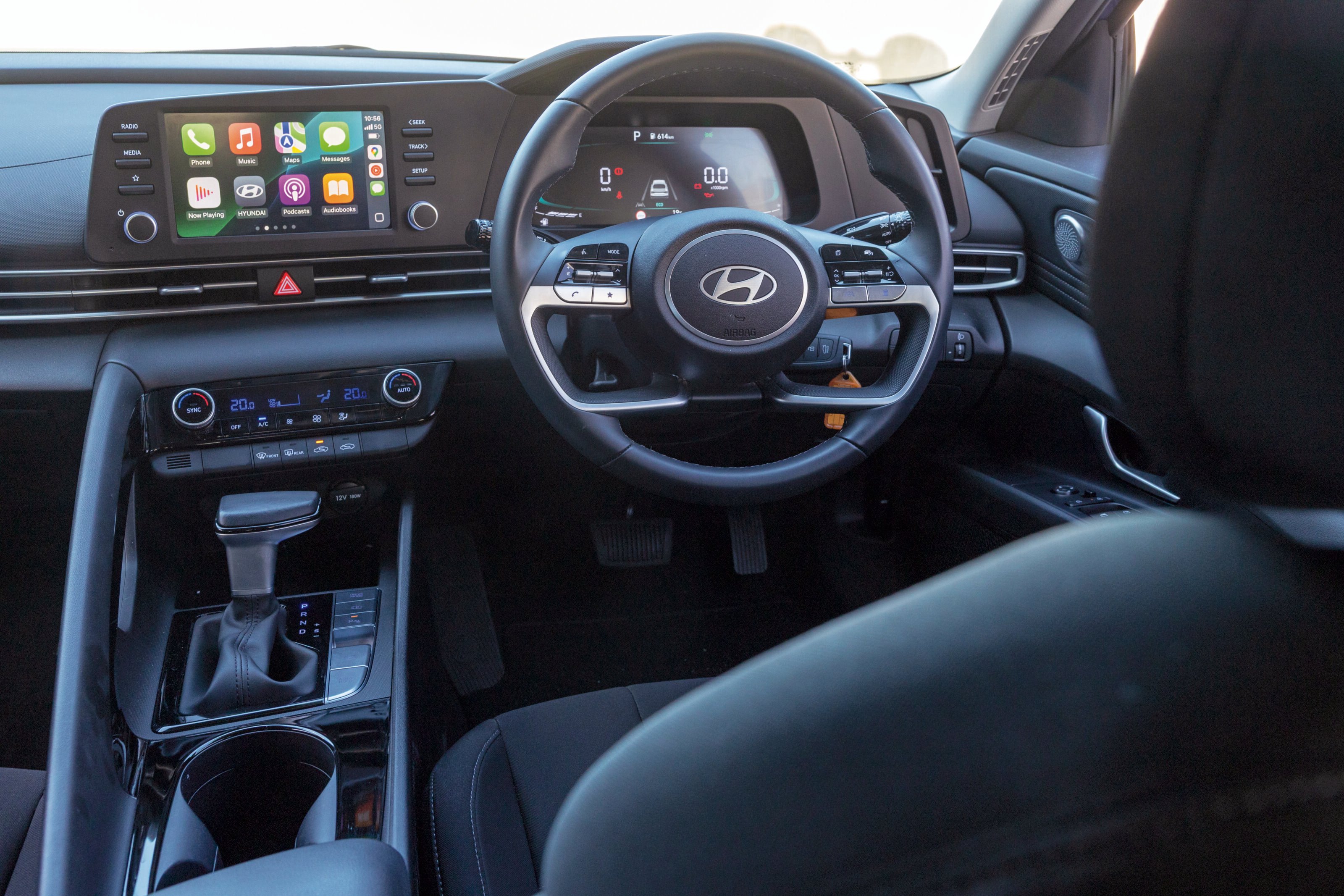
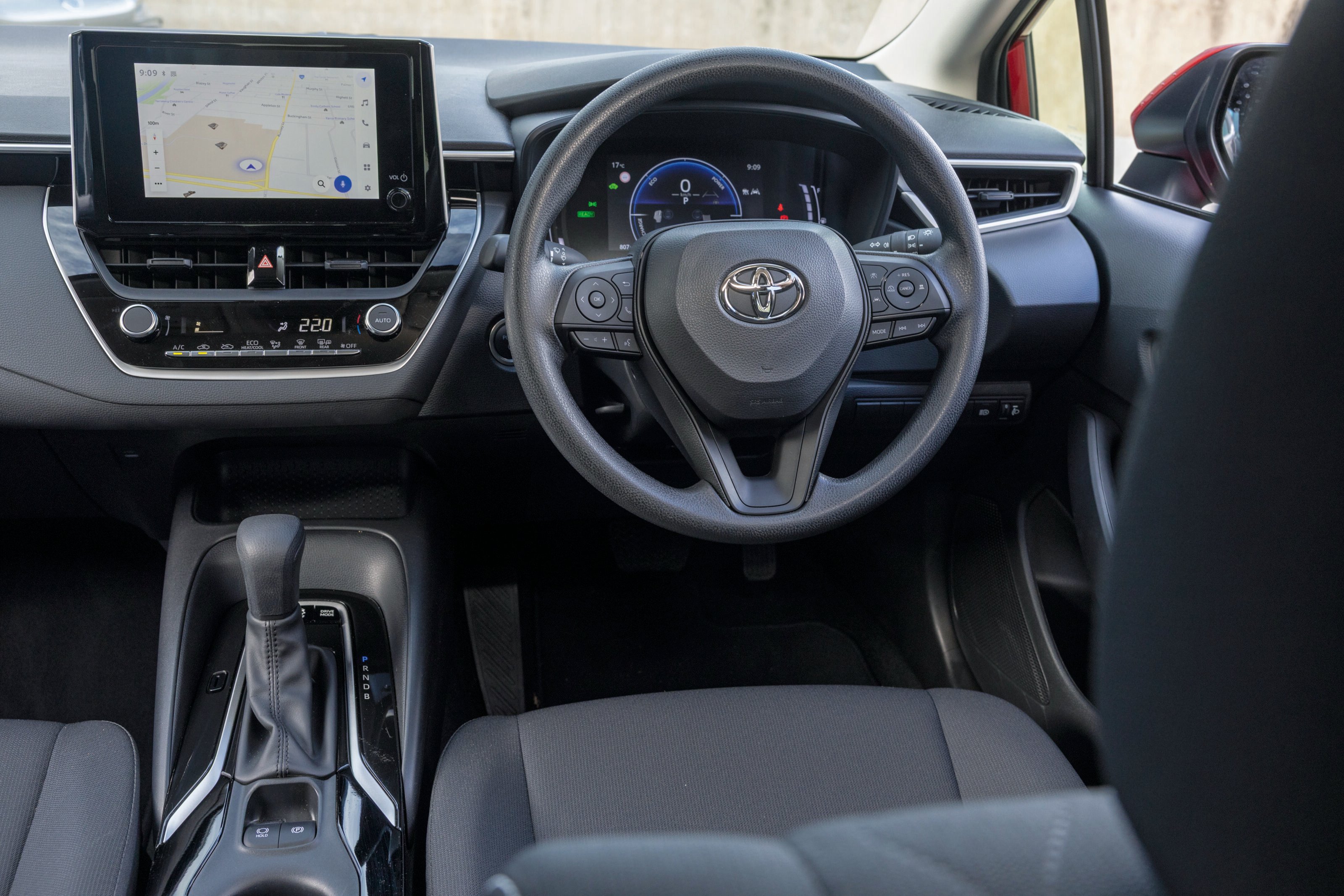
And the Corolla feels the oldest. That’s especially true jumping straight into the MG with its smart, contemporary interior design. Credit to MG, it tries a lot harder than Toyota to please its owner with little splashes of funky patterns and colour.
For space, too, it’s quite a large interior for a light hatch, although the lack of steering wheel reach adjustment means you can’t sit yourself quite as comfortably as the other cars. The interior also doesn’t feel as good as it looks, whereas the opposite is true of the Corolla.
But on the whole, for interior space, design, quality and technology, it’s Honda, then daylight to the rest.
Most of these cars will spend their lives huddled in the herd of everyday traffic, regularly stopping and starting in a perfect hybrid habitat. In the urban environment of inner-city Melbourne at least, there’s one car that initially stands out for its low-speed manners.
The Toyota is breathlessly easy to drive in the city. The controls feel great, and it might be made of plastic but there’s something about a thin-rimmed steering wheel. The steering itself is effortlessly light, the turning circle tight and U-turns are so easy, they’re almost executed using nothing but thought alone.
Just off throttle tip-in, the Corolla gives its driver a lovely vein of responsive, eager electric motor torque. The CVT powertrain is smooth, quiet, efficient and for the large part invisible – just as it should be. Sprung for ride quality, the suspension glides over most inner-city bumps. If you had to do thousands of inner-city kilometres each week as an Uber driver, the Corolla would be a fine companion.
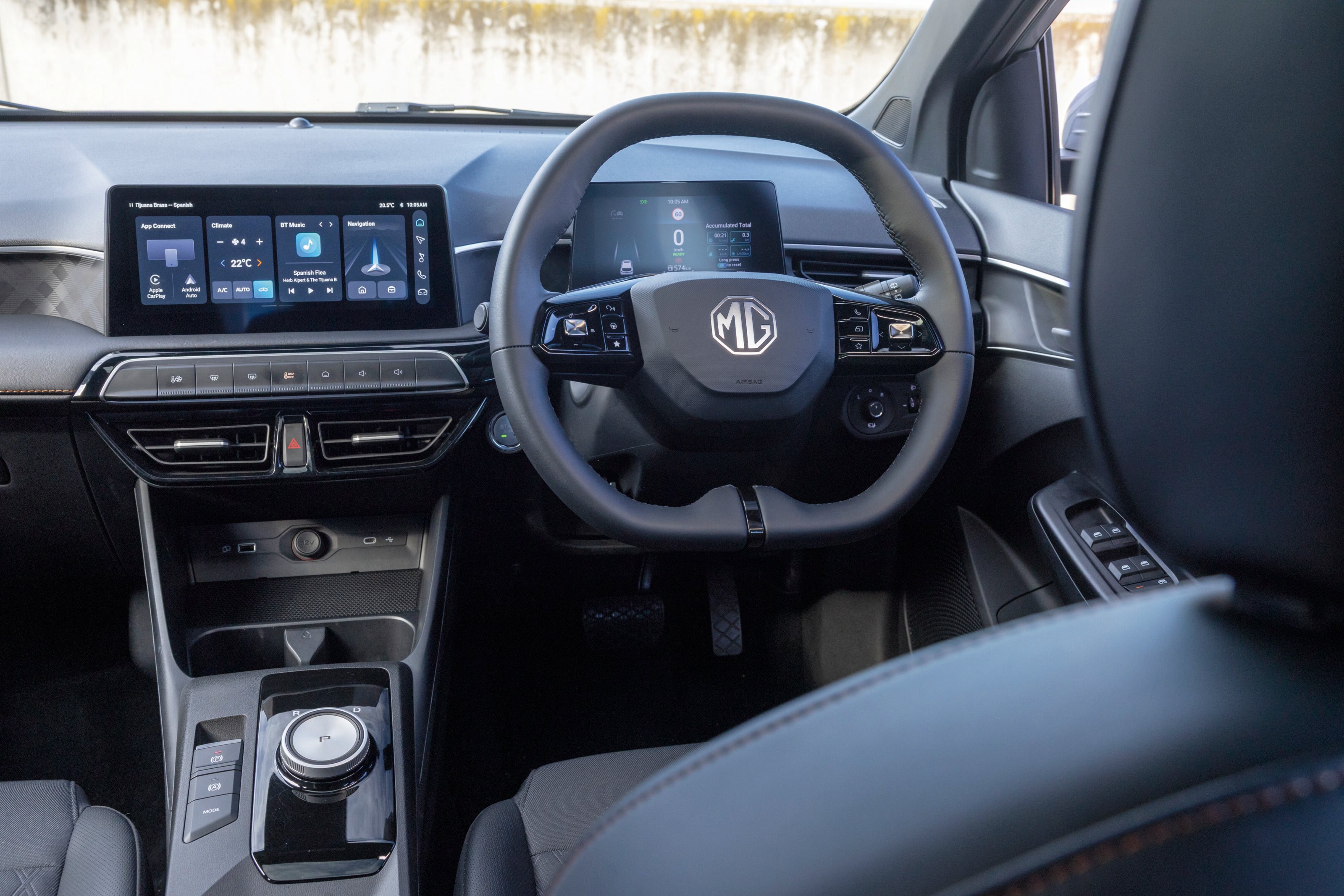
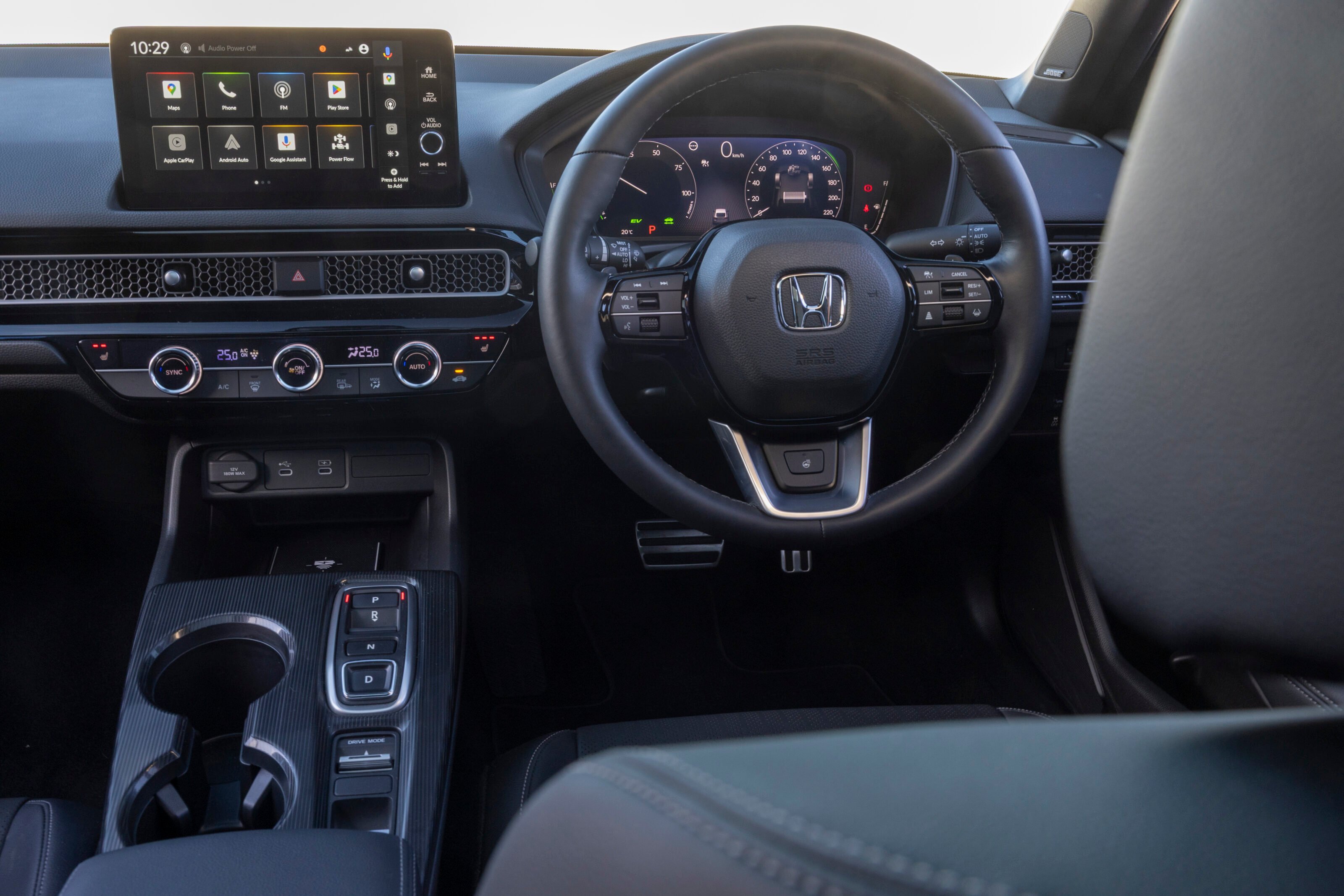
It’s a similar story for the Hyundai although it loses some marks for ultimate smoothness because of its dual-clutch gearbox. We could be imagining it, but it almost feels like the electric motor is driving through the transmission, meaning the perceptible clacking of first to second gear when motoring off using only the electric motor. The car also seems to need a moment to think when selecting reverse. For the most part, however, the powertrain is smooth, the transition from electric motor to combustion engine minimally noticeable and the ride quality comfortable. Another car competently prepared for the Uber grind.
The MG3’s hybrid system works well and you’re aware you have a bit more electric muscularity under your right foot than some of the other cars here. That means looking down to see you’re shifting along using only the electric motor right up to speeds of 60km/h or more. Although compared with the other cars here, it somehow feels less refined – even using a supposedly inherently smooth and quiet electric motor. We don’t doubt MG has come a long way, and the MG3 is on another planet to the brand’s earlier cars, but when it comes to the driving details, it still feels a bit of a crude thing.
The Honda is the most grown-up city car here. It feels the largest but its major controls are also the best calibrated. Selecting drive takes a simple press of a button on the neat and compact shift-by-wire console. The well-weighted steering is a delight to use, as are the brakes. The recuperation is so imperceptible you’d assume an uninterrupted mechanical connection between your foot and the brake pads and discs. Honda has done a magic job of the software here.
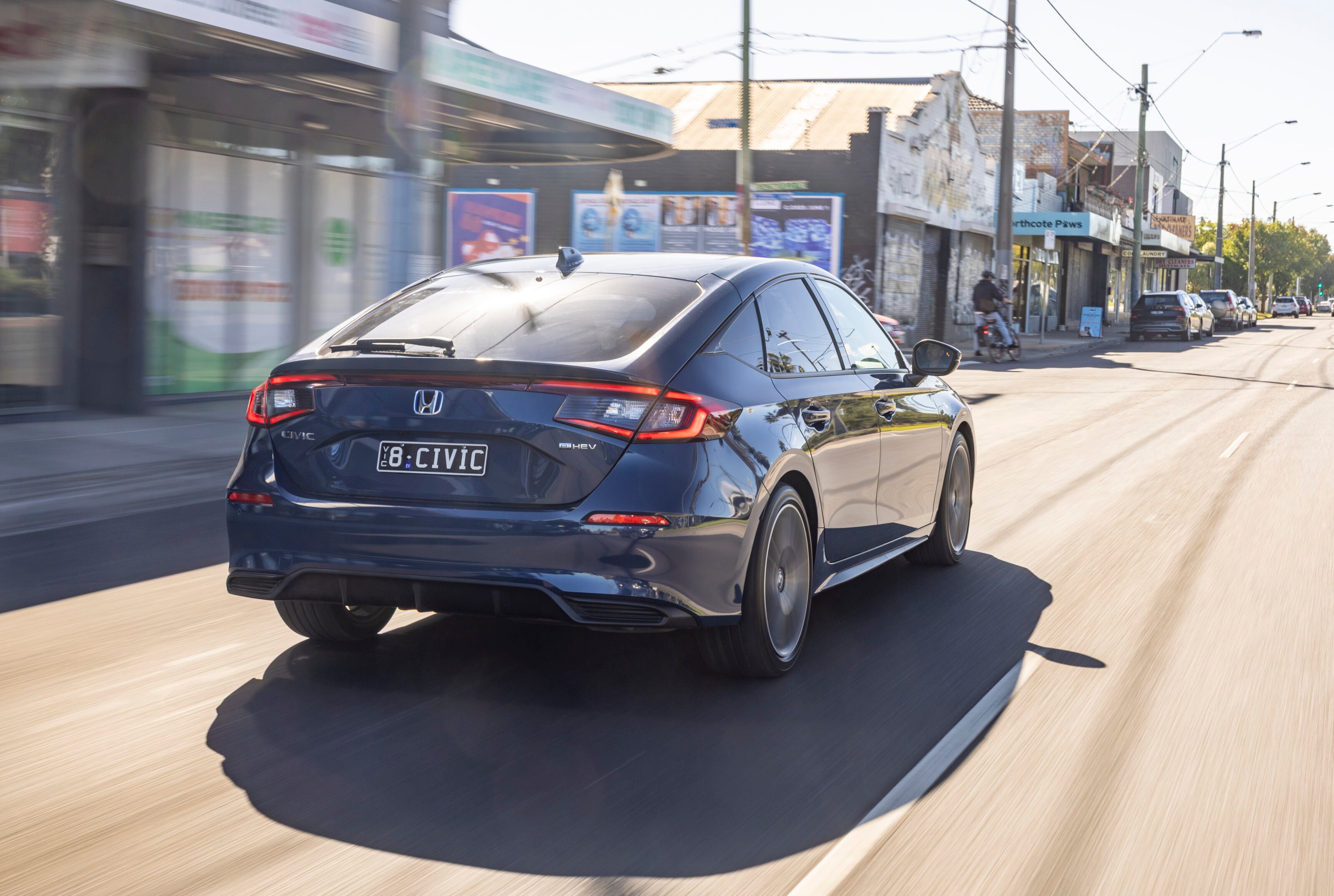
The Honda’s ride quality is the firmest with a bit of a sporting edge, but it’s never uncomfortable. The electric motors provide plenty of near-silent urge, making the Civic eHEV a joy to drive.
If we had to penalise the Civic for anything, it would be the 235-section Michelin Pilot Sport 4 tyres which can pump a surprising level of noise, vibration and harshness into the cabin. A quieter, less-sporty tyre may have been a more considered choice for this car. What the Michelin does hint at, however, is some serious dynamic ability. And that’s absolutely the case.
After a brief motorway stint, we find ourselves on a winding road to test the dynamics of these hybrids – and to see who’s hot, and who’s just flustered.
We start in the Civic. In its Sport mode, there’s decent acceleration – if nothing hair-raising – and it punches out of corners with eager torque from its electric motors, if never bothering traction. The brakes offer tremendous feel into corners, and the direct and tight steering allows the effortless aiming of an eager nose to the apex. The Civic sits flat through corners with a surprising amount of grip, partly courtesy of its independent rear suspension. Dynamically, this is a very competent car, and it feels fast. There’s depth that invites you to dig deeper and push harder. It’s begging for grippier tyres.
You can’t help but wonder if Honda created the current Civic around the Type R, and spun-off some hybrid, mass market variants below it – rather than the other way around.
Curiously, the powertrain simulates a transmission with gear changes and a bit of not-unappealing, rorty fake induction noise, to the point that you’d almost wonder if it’s been keeping a dual-clutch secret from you this entire time. (Sadly, the steering wheel paddles don’t simulate gear changes – they only adjust the brake regeneration levels. If only they did.)
Jumping into the Corolla after the Civic feels like giving it a hard act to follow, especially as we manually adjust the cloth driver’s seat and grip the plastic steering wheel. But the Corolla is a surprise. While it’s not as fast and grippy as the Civic, the steering rack is fast, the brakes feel good and it has more than enough acceleration to exploit the skinny, efficiency-focused tyres.
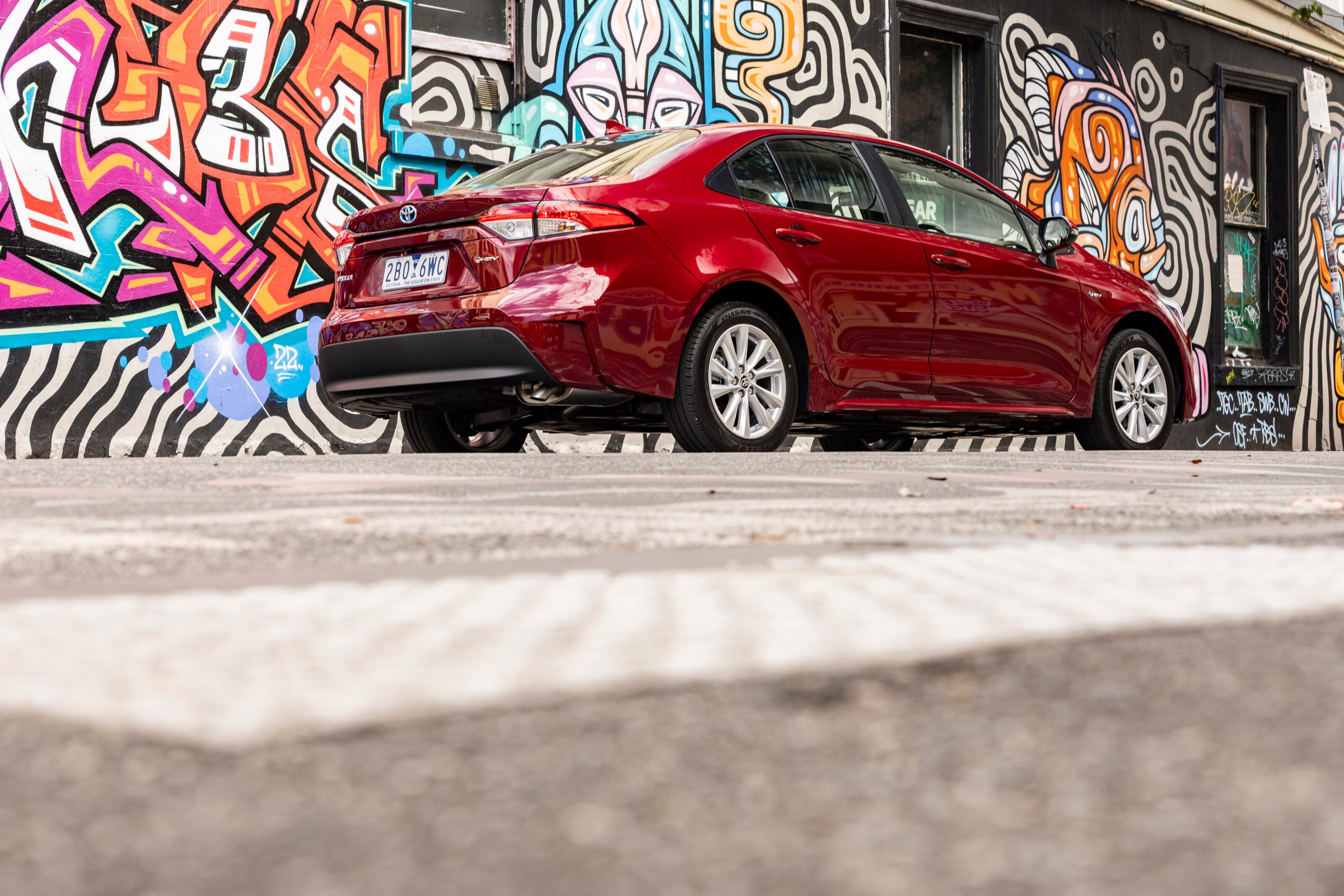
And there’s a bit of sparkle to the chassis, whose soft but never wayward suspension moves through elegant arcs. There’s almost a bit of ND Mazda MX-5 about it. It’s fun. The Corolla’s narrow dimensions also mean you can carve a bit of a line through your typical lane, one which the Civic filled.
It doesn’t sound as good as the Civic – under full throttle, the engine drones in higher revs courtesy of its soul-sapping CVT. But as a package, the 1430kg Corolla is surprisingly engaging. It’s no wonder it so successfully spawned a GR derivative.
It’s a similar story for the Hyundai, and at this point it’s not hard to tell the three cars here all with independent rear suspension that have all successfully underpinned performance variants.
The teetotaller baby brother of the i30 Sedan N, you can pop the Hyundai into manual mode and enjoy playing with some gears, although don’t expect a surprise DSG as economy still very much rules the day. Responsiveness is tepid at best.
The 1360kg Hyundai’s chassis doesn’t quite have the fizz of the Corolla’s, but it attacks corners with competence and zeal, enough to encourage you to push harder and harder. The engineering fundamentals clearly run deep, and there’s fun to be had – if you don’t roast the brakes.
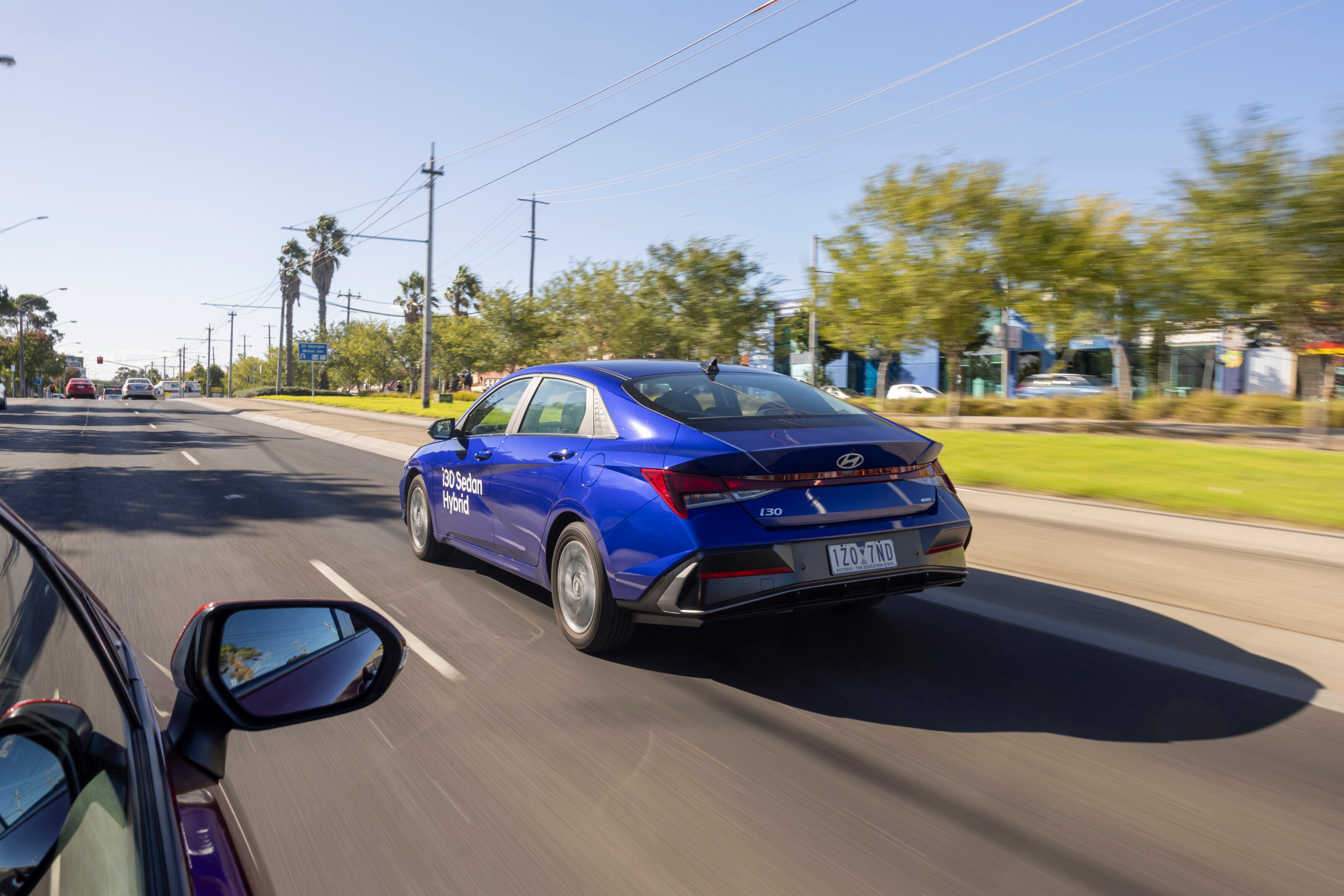
Which leaves one last car. And of all the hybrids present, it was with a mix of curiosity and trepidation we jumped into the MG3. Its Torsion beam rear suspension has served generations of French hot hatches very well, but a French hot hatch the MG3 isn’t.
With a higher seating position and low scowl, there’s very much the sensation of sitting ‘on’ the MG3 rather than ‘in’ it. To its credit, however, if we held a drag race, there could be a massive upset in this crowd.
Put your foot to the floor and there’s a good moment as the car thinks about what you’re asking of it, shuffles to the lowest of its three gears and orchestrates a slightly unnerving coming together of hydrocarbons and electrons. In the MG3’s case, that’s 155kW and a healthy 425Nm – enough to make this little hatch plenty brisk in a straight line.
What it also does, along with the 1308kg kerb weight (quite portly for this size of car), is make the chassis feel easily overwhelmed. The handling is better than you might expect, but the large power, large weight and smaller footprint mean the MG3 feels nervous and twitchy on the way into, and in the middle of, corners. The steering is woolly and vacant, and there’s no way to manually change gears. The engine sounds like it’s not having fun, and ultimately to punt an MG3 hybrid hard is to feel like you’re making it do something it really doesn’t want to.
Of course, few owners of these cars will be taking them to a winding road and subjecting them to such misuse. Zero to 100km/h will matter much less than L/100km. On our test, the Hyundai recorded an average consumption of 5.3L/100km, while the Toyota was just ahead with 5.2L/100km. The MG crept in next with 5.05L/100km, although it loses a few marks here for needing 95RON premium unleaded fuel. All the others take 91RON.
The Honda, surprisingly, did 4.6L/100km over the test on average. Take it all with a modicum of sodium, however, as we’d want to do a much longer drive of each before drawing any solid efficiency conclusions.
All infotainment systems work as you’d hope and have Apple CarPlay and Android Auto. For safety, both the MG3 and i30 only scored three stars in ANCAP crash-testing, but under the newer, stricter 2024 regimen. The Honda scored five stars in 2022 but probably couldn’t again in 2024. The Corolla is so old now, its 2018 five-star rating has expired.
For back seats, all can fit two adults reasonably comfortably, although the i30 wins for outright space and the Honda for ambience. The Corolla gets some demerit points for the absence of rear air-vents and USB outlets. Dare we say, if the Corolla was a Chinese-made car, it’d get a bollocking for this.
For boots, predictably the MG’s comes in the smallest at 293 litres. No such concerns for the Corolla or i30 which, at 470 litres and 474 litres respectively, offer deep and truly Caprice-like luggage space for the size of car. The i30’s enormous boot opening resembles a giant mouth ready to swallow up several full-size suitcases. A tick for outright size, however no external button to open the boot, at all, seems extraordinary in 2025. And especially for a vehicle likely to pound the Uber pavement. The Honda one-ups them all, however, for its liftback granting easy, almost top-down access making the most of every one of its boot’s 409 litres.
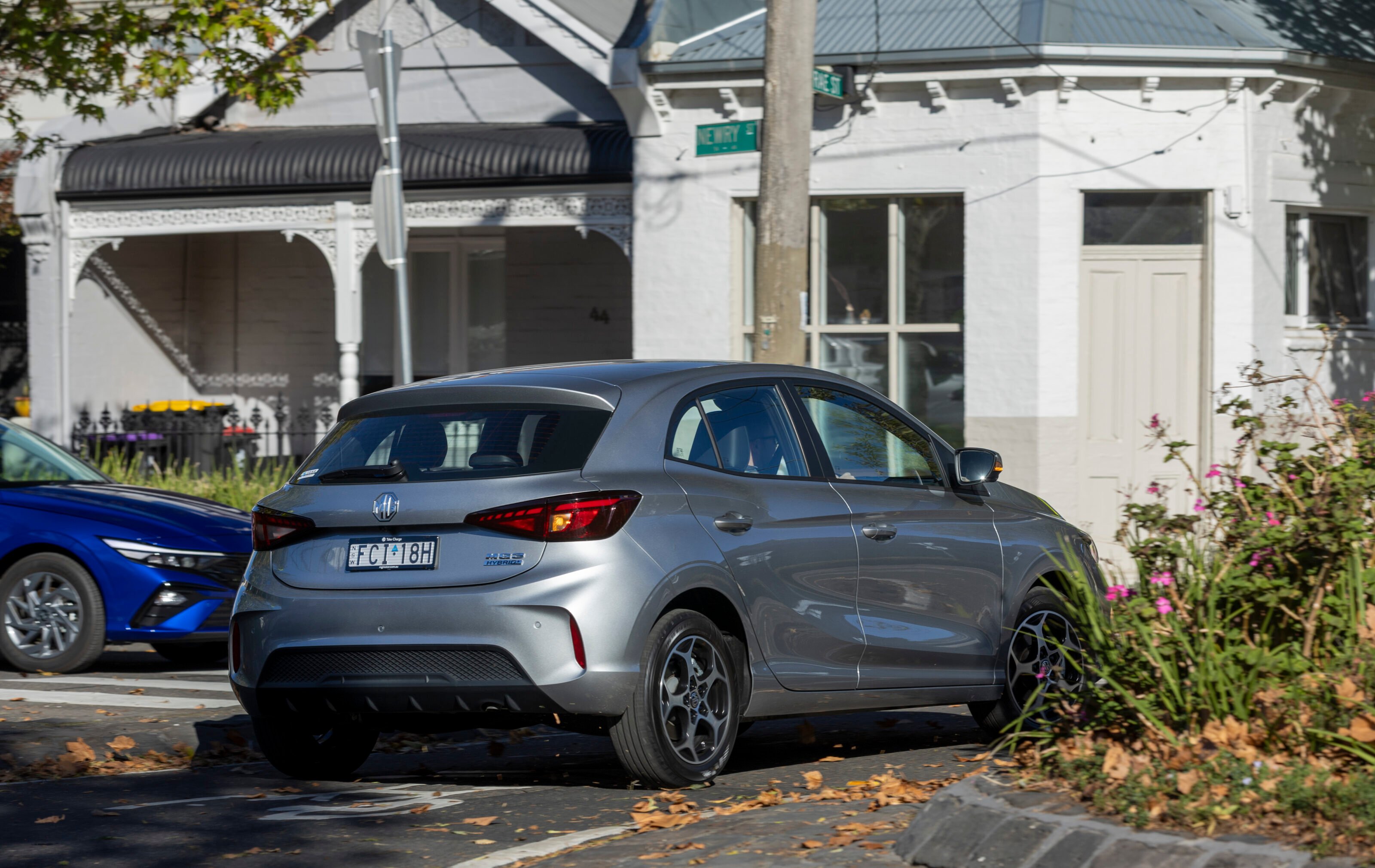
For warranties, it’s an easy win for the MG which, with its 10-year, 250,000km offering, has twice the warranty of the rest. That also covers the battery. Honda is next, warranting your Civic for up to eight years provided you get it serviced to schedule and at a Honda dealership. Hyundai and Toyota offer standard five-year, unlimited kilometre policies. Hyundai will cover the hybrid battery for eight years or 160,000km. Toyota covers its hybrids’ traction battery for 10 years.
Proving, as ever, the financial devil can be in the detail, the Honda might be the priciest vehicle here but at $995 over five years, it’s the cheapest to service by a long way. The Toyota is next at a reasonable $1225, the Hyundai $2180 and the MG a surprisingly pricey $2423 over five years.
We said at the start of this story that this isn’t a direct comparison, and it isn’t. But we can leave today with a few final thoughts.
The MG3’s hybrid system is mighty impressive for what amounts to something of a first effort, and it will only get better, more refined and more efficient in time. The Japanese and Korean manufacturers can’t afford to rest on their laurels, sit still or not be hungry. And as a car, the MG3 shows just how far this brand has come in the last decade. It’s a pretty great little thing and it tries hard, especially for the price.
Hyundai has done a superb job creating a true, Toyota-rivalling hybrid system. In other comparison tests, we’ve found Hyundai’s hybrid system to match, or beat, the Toyota powertrain in a direct fight. Hyundai is doing exactly that across its range, from Kona to Tucson to Santa Fe – and i30 Sedan.
The Corolla, meanwhile, is incredibly frugal, and in a longer, more scientific test, we would still bet on it going the furthest for the least amount of fuel. The bigger surprise is just how well it drives. If only this grade didn’t make us feel like we had a stranger to pick-up.
Given it’s the priciest vehicle here, you’d hope it was the Honda we’d take home from this test – and it is. It’s a highly fuel efficient warm hatch. It’s the best driver’s car here by a mile, but it’s still lovely to drive around town. The interior quality is almost befitting a pricier car – that’s saying something given it already costs fifty-six grand. A Civic.
On the whole, the Civic eHEV removes the blindfold as to how complete, competent and even desirable a hybrid vehicle can be.
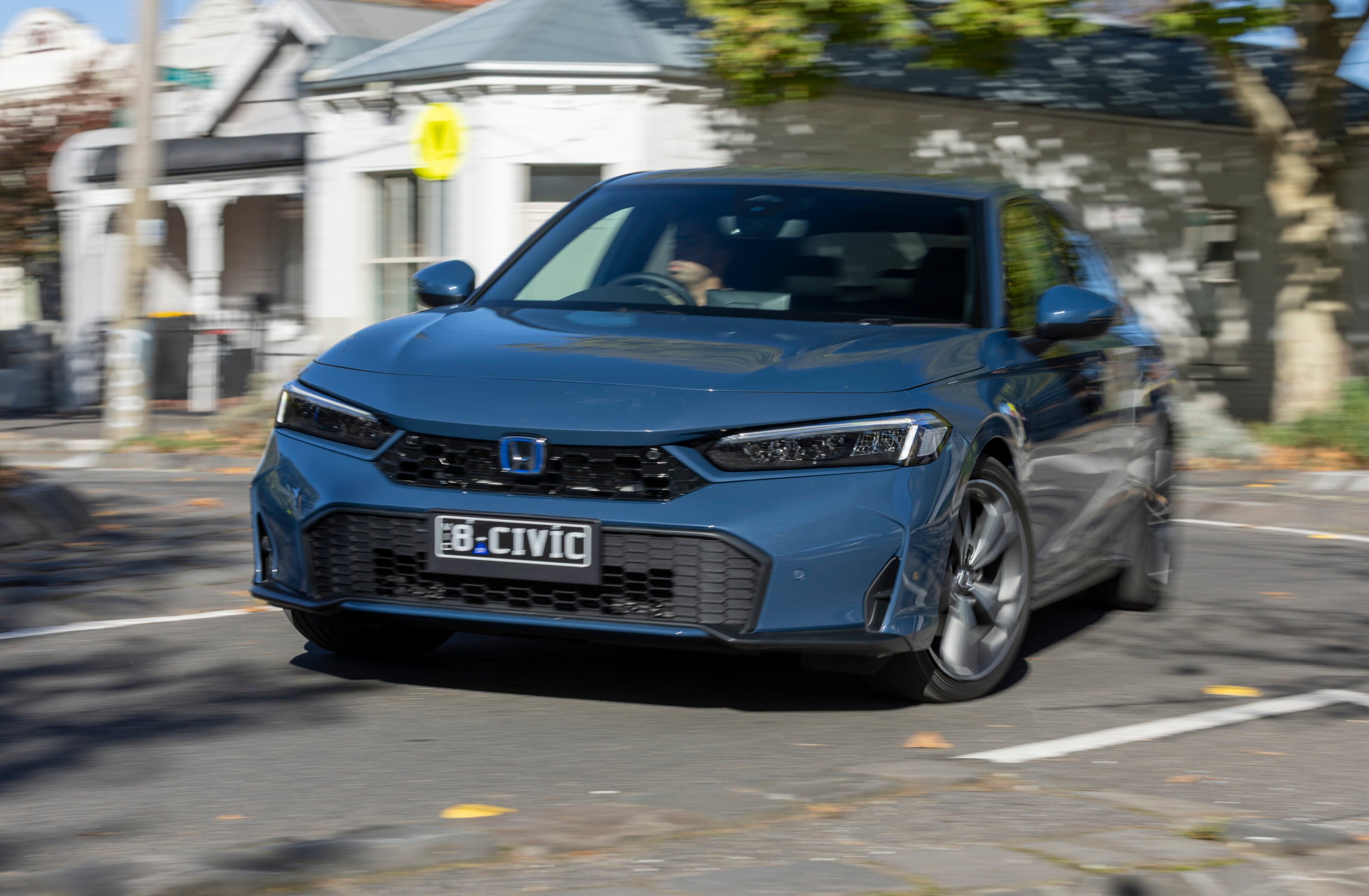
Specifications
MG3 HYBRID+ Essence
| Engine | 1498cc inline-4, DOHC, 16v |
|---|---|
| Power | 155kW |
| Torque | 425Nm |
| Battery | 1.83kWh |
| Transmission | 3-speed automatic |
| L/W/H/W-B | 4113/1797/1502/2570mm |
| Weight | 1308kg |
| Fuel consumption | 4.3L/100km (claimed) |
| CO2 emissions | 100g/km (claimed, combined) |
| Boot (L) | 293 |
| 0-100km/h | 4/5 |
| 0-100km/h | 8.0sec (claimed) |
| Warranty | 10-year/250,000km, 10-year roadside assistance |
| 5-year/50,000km service cost | $2423 |
| Price | $29,990 |
Hyundai i30 Sedan Hybrid
| Engine | 1580cc inline-4, DOHC, 16v |
|---|---|
| Power | 104kW |
| Torque | 265Nm |
| Battery | 1.32kWh |
| Transmission | 6-speed dual-clutch |
| L/W/H/W-B | 4710/1825/1420/2720mm |
| Weight | 1360kg |
| Fuel consumption | 3.9L/100km (claimed) |
| CO2 emissions | 92g/km (claimed, combined) |
| Boot (L) | 474 |
| 0-100km/h | 9.5sec (estimate) |
| Warranty | 5-year/unlimited km, 12-month roadside assistance |
| 5-year/75,000km service cost | $2180 |
| Price | $33,000 |
Toyota Corolla Sedan Hybrid Ascent Sport
| Engine | 1798cc inline-4, DOHC, 16v |
|---|---|
| Power | 103kW |
| Torque | 142Nm |
| Battery | 1.3kWh |
| Transmission | CVT |
| L/W/H/W-B | 4630/1780/1435/2700mm |
| Weight | 1430kg |
| Fuel consumption | 3.9L/100km (claimed) |
| CO2 emissions | 90g/km (claimed, combined) |
| Boot (L) | 470 |
| 0-100km/h | 8.1sec (estimate) |
| Warranty | 5-year/unlimited km, 5-year roadside assistance |
| 5-year/75,000km service cost | $1225 |
| Price | $32,320 |
Honda Civic eHEV LX
| Engine | 1993cc inline-4, DOHC, 16v |
|---|---|
| Power | 135kW |
| Torque | 315Nm |
| Battery | 1.05kWh |
| Transmission | 1-speed |
| L/W/H/W-B | 4569/1802/1415/2735mm |
| Weight | 1497kg |
| Fuel consumption | 4.2L/100km (claimed) |
| CO2 emissions | 96g/km (claimed, combined) |
| Boot (L) | 409 |
| 0-100km/h | 7.3sec (claimed) |
| Warranty | 8-year, unlimited km (conditional), 8-year roadside assistance |
| 5-year/50,000km service cost | $995 |
| Price | $55,900 (drive-away) |

